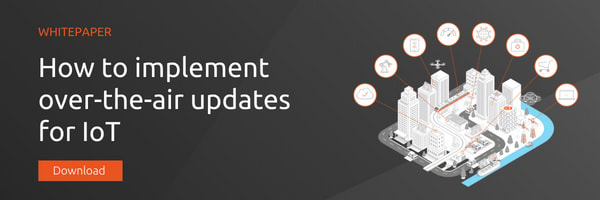Holly Hall
on 24 October 2022
What does OTA mean? [Part I]
In the second part of this blog series, we cover the top 3 reasons why OTA updates are important. Read more about the importance of OTA technology in the blog post here.
OTA is a term commonly used when working with any type of device. Simply, the abbreviation OTA means ‘over-the-air’, and refers to the distribution of information wirelessly. In the context of IoT, you will often hear it used in combination with “updates”. Let’s explore in more detail what OTA is.

What is OTA?
Most people who own a computer have experienced the installation of an OTA update. For mobile phone users, it’s taken place in their pocket. This could be to upgrade to the newest operating system or get the latest version of an application. Over-the-air updates take place remotely, with no wired connection. This enables distributed devices to stay up to date and secure, allowing new security patches to be installed anywhere. In addition, it allows installation of new features, providing more functionality from the developers of the product. These updates can relate to software, hardware or firmware.
OTA updates are a huge factor in the growing success of IoT and the proliferation of consumer devices around the world. This technology has enabled wireless devices, like mobile phones, to be placed in the field and still receive critical updates.
Imagine if a technician had to physically visit each device in the field to plug in and run an update process. Now, think of all the hardware that you have in your home, you see on the street, in shops or in offices. This task would be incredibly tedious and waste a lot of time for the technician. Being able to push updates to every smartwatch, robot vacuum cleaner, weather station or printer remotely allows the technician to focus on other tasks and makes the entire update process seamless.
OTA in IoT: points to consider
Using over-the-air updates for the Internet of Things provides a wide range of advantages. There are important factors to consider when evaluating whether to use OTA, depending on the use case. Let’s explore the advantages and points to consider for OTA.
Key advantages
As mentioned above, using OTA technology makes the update process easy and convenient. This is one of the key advantages to using OTA updates. It vastly reduces the need for physical presence at the device to perform routine maintenance. Taking into account the millions of devices in the field, this saves a significant amount of time and resources. A key part of this story is the way OTA updates allow hardware distributed around the world to stay secure. Let’s say a laptop manufacturer discovers a security bug on a piece of software. In this situation, OTA updates allow the security fix to be pushed to computers around the world simultaneously. This enables and secures distribution of devices globally.
Similarly, reliability is key when considering which OTA technology to adopt. A fleet of updates with poor OTA functionality will be left unprotected if they do not receive updates. One of the more advanced (but necessary) features of OTA is rollback. If for any reason an update you push to your devices fails, there needs to be a fallback mechanism to protect the device. If the update mechanism is not handled correctly, the device could fail to run correctly or even be bricked. Using an advanced OTA process prevents damage to the device. In the case of update failure, the device will roll back to its last stable state. This allows the engineer to identify the error that took place and correct it before pushing the update again.
Considerations in IoT
OTA updates can be fast, but updating your hardware over a wired connection is almost always faster. OTA updates still need a reliable network to transmit information. The higher the networking speeds, the faster the update can be downloaded and uploaded to the device. Additionally, when thinking about updates it’s important to have a versatile mechanism to add new hardware and scale your fleet of devices. Imagine you just released a new model of smart speakers. In this case, all the smart speakers manufactured and sold need to be onboarded to ensure that you can push updates to them when they are distributed. The ability to quickly scale, add new devices and release new updates to those devices improves the entire workflow for device manufacturers and IoT companies.
Despite all the advantages of OTA, one of the key concerns is security. The devices that benefit the most from OTA updates are distributed in the field. Sometimes, this hardware is more easily-accessible than wired devices, or can be intercepted more easily. Despite this, there are security risks associated with all technologies, so this should be considered when evaluating OTA update mechanisms.
Updates can be either automatic or manual. When updates are automatic, they happen in the background. When updates are manual, the user has to select exactly when they want the upgrade to take place. Sometimes this choice is made by the user. In other cases the manufacturer of the device or the software provider will make this choice. Automatic updates ensure that the device is always up-to-date and secure. If a user postpones updates for a long time, this leaves the hardware vulnerable and at increased security risk. If the mechanism is automatic, it is important to be able to schedule the update so it does not take place as you are using the device – this could cause an interruption to the operation of the device.
OTA updates for Linux
OTA updates in IoT are extremely important for the operation, maintenance and distribution of devices. The capability for new devices grows as OTA technology continues to improve, unlocking more sophisticated rollback mechanisms and scaling. Harnessing the power of OTA can unlock new features for a range of devices globally.
Canonical’s OTA technology offers all the advantages discussed in this article, with additional features such as using deltas to reduce bandwidth consumption. A number of IoT customers use this technology in the field to power their devices with Ubuntu Core. You can try it for free using the global Snap Store. To harness this technology for larger-scale IoT projects, learn more about the dedicated Snap Store.
If you are interested in IoT, looking for inspiration for your next endeavour or already have a project in mind, get in touch. Explore the following links to learn more:
- How to implement OTA updates for IoT
- 3 reasons why OTA updates are important [Part II]
- A practical guide to IoT lifecycle management
- Top 5 IoT challenges and how to solve them
- Technical introduction to Ubuntu Core 22
- Guide to embedded Linux: make or buy?
Photo by Andrew Wulf on Unsplash




